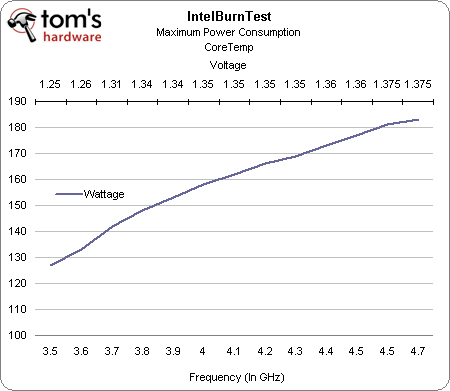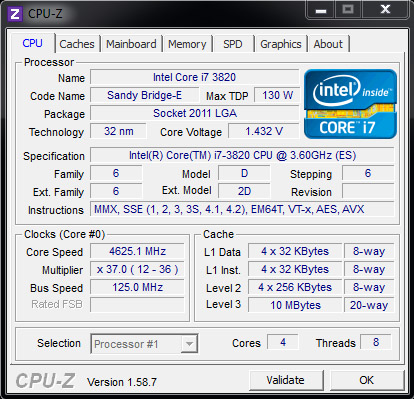Intel Core i7-3930K And Core i7-3820: Sandy Bridge-E, Cheaper
Core i7-3960X is undeniably fast. But at more than $1000, it’s hardly an option for most enthusiasts. We got our hands on the Core i7-3930K and Core i7-3820 to gauge their overclocked performance and determine if they’re able to best the flagship part.
Overclocking Sandy Bridge-E On A Budget
Overclocking Core i7-3930K
Now, you don’t swap out a $300 motherboard for a $225 platform and expect the same experience, so I initially tempered my expectations of overclocking on ASRock’s X79 Extreme4-M.
That was premature, though. Using the company’s latest firmware, I had no trouble booting up at 4.4, then 4.5, 4.6, and finally 4.7 GHz. Those last two frequencies were fine for benchmarking, but they gave out under IntelBurnTest, compelling me to settle in at a modest 4.5 GHz.
I could have gone higher. The chip’s power consumption crested at 183 W at 1.375 V, and ASRock indicated to me that its board should take 200 W or so. Given a 91°C ceiling and temperatures that topped out around 80°, thermals weren’t the problem. The Core i7-3930K wanted more voltage. But even the settings I used aren’t guaranteed to be safe over the long term, so it wasn’t worth it to me to nudge up to 1.4 V.
With all of that said, 4.5 GHz was rock-solid down at 1.361 V, so long as the most important variable was controlled: cooling. I used Intel’s RTS2011LC for my processor, which left the X79 Extreme4-M’s VRM vulnerable. Naturally, instability ran rampant even at lower power levels. Simply adding a fan blowing over the motherboard solved all heat-related issues.
As a general rule of thumb, it’s possible to get great clock rates from the Sandy Bridge-E-based chips we’ve tested, so long as you’re willing to put plenty of voltage through them and throw big cooling at the resulting heat. We’ve talked to system builders willing to go 4.4 GHz on shipping machines, so our 4.5 GHz overclock on a retail-purchased processor turns out to be pretty solid.
Overclocking Core i7-3820
Get Tom's Hardware's best news and in-depth reviews, straight to your inbox.
The Core i7-3820 hits respectable frequencies as easily, but it requires a slightly different approach. Because it’s neither an X- nor a K-series SKU, the -3820 is constrained by “limited overclocking.” In short, it scales up to six 100 MHz bins beyond its maximum Turbo Boost clocks. With three or four cores active, it hits 4.3 GHz. When one or two cores are busy, it jumps to 4.4 GHz.
That leaves performance on the table, though, making it necessary to exploit the strap ratios incorporated into the X79 Express platform. ASRock’s X79 Extreme4-M doesn’t expose them explicitly, though we’ve asked the company to add the ratios, and it now plans to. However, manually specifying 125 MHz, for example, allows the PCI Express and DMI buses to remain within spec.
Interestingly, our -3820 didn’t want to run at 4.5 GHz, but it worked at 4.625 and 4.75 GHz using 37x and 38x multipliers. Still finicky, it wouldn’t complete the entire benchmark suite, even with a longevity-unfriendly 1.44 V driving it. But my expectations for this one weren’t high anyway. And if you need a quad-core chip, I don’t see any reason to buy a high-end platform (X79), quad-channel memory kit, and a locked processor when the Z68/Core i7-2600K combo is cheaper, still very capable, and equipped with Quick Sync support.
Current page: Overclocking Sandy Bridge-E On A Budget
Prev Page Core i7-3930K And -3820 Get Reviewed Next Page Test Setup And Benchmarks-
compton This is a really excellent analysis. Clearly, I must be drinking at the wrong places because I never leave the pub with any hardware nicer than a hangover.Reply -
theuniquegamer So nice overclocking at 4.5ghz. I can expect that the upcoming ivy bridge unlocked series may be stable atleast 4.2 will all 4 cores active. I can't wait till Q2 next year to see benchmarks .Reply -
Dacatak Possible TYPO in the bottom graph for Dirt 3 benchmark.Reply
FX-8150 benchmark with no AA says "68.8" FPS. I think it's more like "48.8". -
JOSHSKORN For gaming (the high end CPU intensive), is there any noticeable difference between the 2500k and the 3960X?Reply -
Dacatak JOSHSKORNFor gaming (the high end CPU intensive), is there any noticeable difference between the 2500k and the 3960X?Reply
If by "noticeable" you mean "perceivable to mere mortals", then no.
If you can in fact notice the difference between 105 vs 110 FPS, then you are a god, and you deserve only the best. -
spunkyddog I bought the i7-3930K with 32GB of DDR3 1600 RAM last week and assembled a couple days ago. I have two Kingston 120GB SSDs in RAID that have been benched on my system at a theoretical 1,100MB/S Read and 1,300MB/S Write. Coming from a Pentium D 3.0GHz, this was like night and day. My renders went from 40minutes to 1minute. I'm not overclocking purely for the fact that this thing's a beast already and I'm doing high-end 3D work using Maya, Photoshop, After Effects, Video, etc. Also - I like the peace and quiet.Reply
Intel did an awesome job with the SBE line - despite the fact that we're missing some wanted/promised features (native support for USB and PCI-Express 3.0. I'm waiting out for the PCI 3.0 cards before I upgrade my graphics... curious if the Asus P9X79 Pro will hold it's promises.
Thanks Chris for reviewing this processor. I felt like I went out on a limb getting this processor over the Extreme, but the $600 was well worth it. -
cangelini spunky,Reply
Glad you're enjoying. You do, actually get PCIe 3.0 support, but no USB 3.0, unfortunately.
Dacatak,
Yup, typo--fixing now! -
sna the only good reason to get X79 is the more ram .. u can get cheap 32G ram system , or go for 64G of ram and enjoy a ram diskReply
it is a good thing -
soccerdocks The Overclocking Sandy Bridge-E On A Budget page states, "With all of that said, 4.5 GHz was rock-solid down at 3.61 V". I'm pretty sure you meant 1.36 V.Reply -
cangelini soccerdocksThe Overclocking Sandy Bridge-E On A Budget page states, "With all of that said, 4.5 GHz was rock-solid down at 3.61 V". I'm pretty sure you meant 1.36 V.Reply
Indeed, fixed! At 3.6 V, we'd have dead Sandy. :)


